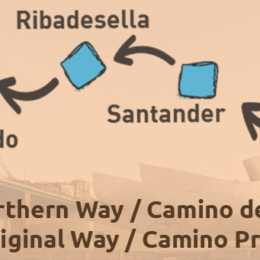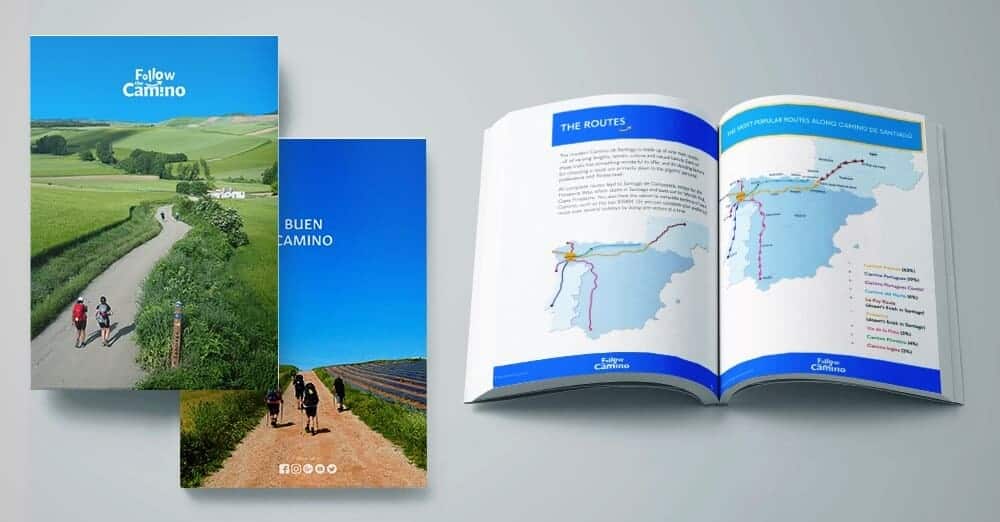The Camino de Santiago has some of the most emblematic and beautiful cathedrals of the world.
With architectural styles that go from Romanesque, Baroque and Gothic, the different Camino routes to Santiago de Compostela are like a paradise. Especially for those who look for a greater experience, not just a holiday.
Find authentic architectural gems. Every cathedral is like an open book to the history of Spain!
Let’s go through our top 5 best cathedrals on the Camino de Santiago.
Cathedral of Saint Mary of Burgos (Camino Frances)
- Location: Plaza de Santa Maria, Burgos, Spain
- Construction: 1221-1567
- Style: Gothic
- Architects: Juan de Colonia, Simon de Colonia, Felipe de Borgoña, Juan de Vallejo, Juan de Castañeda and others.
- Declared UNESCO World Heritage Site in 1984
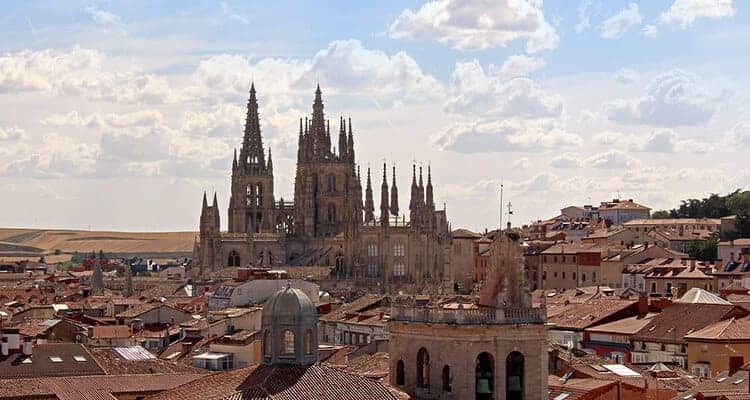
The Camino Frances hides real architectural jewels such as the cathedral of Burgos. As soon as you walk into the city centre of Burgos, the impressive Gothic-style cathedral will leave you speechless. Certainly, declared UNESCO World Heritage Site in 1984, it took more than 4 centuries to build this cathedral.
How was the Burgos Cathedral built?
To know this we have to go back in time when northern Castilla, after being in the hands of the Muslims, was re-conquest by the Christians and they started to build Christian temples again.
The Oca city was destroyed by the Muslims. So, in 1074 its bishop, Don Simon, moved to the Gamonal church. Gamonal is a Romanesque church that was being built in honour of Santa Maria.
In 1075, the king Alfonso VI donated the outdoor area of the royal palace and the church of Santa Maria. He did so in order to the bishop of Oca city to build a cathedral. That’s how the Burgos cathedral was built, on top of the church of Santa Maria, whose name has been preserved to this day.
Who built the cathedral of Burgos?
Finally, in more than four centuries there were several architects who participated in the construction of the cathedral. To this day, there’s no certain data about who was the architect that first started the building. Considering the architectural style of the cathedral, historians deducted that it was a French architect or someone who had studied in France.
Among the most important architects who participated in building the cathedral, we can name Juan de Colonia and his son Simon. They built the towers and open spires of the facade, also the Constable’s chapel, and the Saint Anne’s chapel.
Felipe de Borgona together with Juan de Vallejo, Juan de Castaneda and other collaborators were in charge of the choir, cupola, and lantern tower over the transept crossing.
Francisco de Colonia built the emblematic Puerta de la Pellejeria (1516), the ratable of Gil de Siloe, the staircase of Diego de Siloe and other masterpieces.
There’s no doubt, the Burgos cathedral holds a great representation of late Gothic masterpieces!
Who is buried in Burgos Cathedral?
In the cathedral of Burgos, you can find the tombs of El Cid Campeador and his wife Doña Jimena. There are also the remains of the Constables of Castile and some Church eminencies.
From the embellished exterior with its spiral towers to its splendid interior rich in art works and the starry dome that covers the tombs of El Cid and Doña Jimena, the Cathedra is well worth a visit!
Burgos Cathedral – Opening hours
- Open Monday to Friday from 10:00am-2:00pm and from 5:00pm-7:30pm
- Saturday from 10:00am-7:30pm
- Sunday from 10:00am-5:30pm
- You can get your ticket online or in person, the price is €8.
- Pilgrims can get a €1 discount when their tickets are bought at the Cathedral reception office.
Cathedral of Santa Maria de Regla de Leon (Camino Frances)
- Location: Plaza Regla, 24003 León, Spain
- Construction: 1205-1302
- Style: French Gothic
- Architects: Maestro Enrique, Maestro Simon, Juan Perez
- Declared Asset of Cultural Interest in 1931
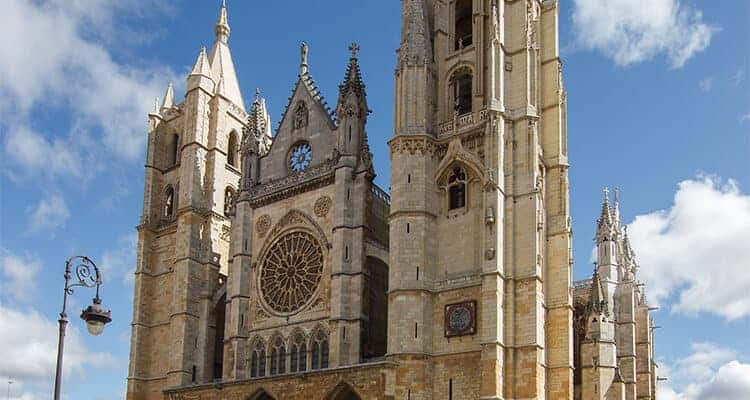
With elaborated carved portals, splendid rose windows and beautiful sculptures such as the Virgen de la Esperanza, the majestic cathedral of Leon is one of the architectural gems that you’ll find on the Camino Frances, on your way through Leon city.
This Asset of Cultural Interest site follows the architectural Gothic style of the French cathedral of Reims and it’s known as the most refined Gothic cathedral of Spain.
How was the Leon Cathedral built?
Before becoming the impressive cathedral that it is today, the cathedral of Leon passed through different stages which include Roman baths and a Royal Palace.
Back in the X century, during the Christian reconquest part of the Roman baths from the II century it served as the base for the new Royal Palace.
After the king of Leon Ordoño II won the Battle of San Esteban de Gormaz against the Arabs, he decided to build the city’s first basilica on top of his palace as a gesture to thank God.
Years later, the king’s sister Princess Urraca, promoted the construction of the Romanesque cathedral, so that it would become a temple in line with the aspirations of Romanesque Christianity.
Who built the cathedral of Leon?
There are three main architects known up to date. Simon, named in the records of 1261, with origins in the French champagne. Followed by Master Henry, who is also said to have had French origins and who directed the works until the year of his death in 1277. Henry also participated in the construction of the cathedral of Burgos.
After Henry’s death, he was replaced by the master Juan Pérez, of Spanish origin.
It is said that the French origin of these two first builders gave the cathedral that French Gothic look, whose features are reminiscent of the Cathedral of Notre Dame and the Cathedral of Reims in France.
Who is buried in Leon Cathedral?
In the ambulatory of the Cathedral of León, is the Mausoleum in which rests the remains of King Ordoño II of León, son of Alfonso III the Great, King of Asturias, and of Queen Jimena of Asturias.
Leon Cathedral – Opening hours
Summer:
- Open Monday to Saturday from 8:30 am to 1:30 pm and from 4:00 pm to 8:00 pm.
- Sundays and bank holidays from 8:30 am to 2:30 pm and 5:00 pm to 8:00 pm
Winter:
- Open Monday to Saturday from 8:30 am to 1:30 pm and from 4:00 pm to 7:00 pm.
- Sundays and bank holidays from 8:30 am to 2:30 pm and 5:00 pm to 7:00 pm
Price: Cathedral: €6 – Museum: €5 -Groups, retirees, students discount.
Back to top page ^Cathedral of San Salvador de Oviedo “Sancta Ovetensis” (Camino Primitivo and Camino del Norte)
- Location: Plaza Alfonso II el Casto, 33003 Oviedo, Asturias, Spain
- Construction: XIII-XVII centuries
- Style: Gothic, Baroque, Romanesque and Renaissance architectural styles
- Architects: Rodrigo Gil de Hontanon
- Declared Asset of Cultural Interest in 1931. Declared UNESCO World Heritage Site (as a part of “Caminos de Santiago de Compostela” n.º ref. 669 bis-005) in 2015.

Just where the Camino del Norte ends and the Camino Primitivo starts, in Oviedo city is located the magnificent cathedral of San Salvador de Oviedo.
How was the San Salvador de Oviedo Cathedral built?
Back in 765, King Fruela I ordered to build a Romanesque church in Oviedo which after 30 years was then destroyed by the Moors.
His son, King Alfonso II The Chaste, decided to move the capital of the Kingdom of Asturias to Oviedo and ordered to build a cathedral complex dedicated to San Salvador, on the same ground where the previous church was.
A complex according to the urbanistic scheme of the High Middle Ages: a double cathedral, unique in its conception, implemented in two buildings with different uses, the residence of the bishop, episcopal dependencies and a defensive wall.
In the following years, this complex was restored on different occasions. For example, at the end of the XII century the chapter house and the cluster were restored.
The construction of the current Gothic cathedral started in the beginning of the 14th century. For that, the previous church was demolished and it took almost three centuries for the cathedral to be finished.
Who built the cathedral of Oviedo?
The cathedral is an example of flowery Gothic Style. There is documentation from the fifteenth century showing that Bartolomé Solórzano, an architect from Trasmiera (Cantabria) who also worked on the cathedral of Palencia, was working on it.
The building of the current facade started at the beginning of the 16th century under the design of Juan de Badajoz. Despite the time of construction, it continues to use the Gothic style instead of the Renaissance.
The New Sacristy was added in 1733, built by Francisco de la Riba Ladrón de Guevara, who also raised the top of the upper cloister and its façade towards the Corrada del Obispo (Bishop’s Compound).
The construction of the Gothic and Renaissance style tower began in 1508 under the direction of Rodrigo Gil de Hontañón based on plans by Juan de Badajoz and was completed in 1587. To a greater or lesser extent, Pedro de Buyeres, Pedro de la Tijera and Juan de Cerecedo also collaborated in the construction.
Who is buried in Oviedo Cathedral?
The Royal Pantheon of Oviedo Cathedral, is now located inside the Chapel of Our Lady of the Chaste King in the Cathedral of San Salvador de Oviedo, which is located on the north side of the cruise. Many members of the Asturian-Leonese royalty were buried there during the High Middle Ages.
According to various historians, some of the most relevant members of the Asturian-Leonese royalty who are buried in the Baroque urns are:
- Fruela I of Asturias (722-768), King of Asturias. Son of Alfonso I the Catholic and Queen Ermesinda.
- Alfonso II el Casto (759-842), King of Asturias. Son of Fruela I of Asturias and grandson of Alfonso I the Catholic.
- Ordoño I of Asturias (830-866), King of Asturias. Son and successor of Ramiro I of Asturias.
- Alfonso III the Great (848-910), King of Asturias. Son of Ordoño I of Asturias.
- Queen Urraca Sánchez (d. 956), wife of Ramiro II of León and mother of Sancho I of León.
Oviedo Cathedral – Opening hours
Open from Monday to Saturday.
- Nov/Dec/Jan/Feb: Open from 10:00am to 1:00pm and from 4:00 pm to 5pm.
- Mar/Apr/May/Sep/Oct: 10:00am to 1:00pm and from 4:00pm to 6:00pm
- Jun/Jul/Aug: 10:00am to 1:00pm and from 4:00pm to 7:00pm
General admission (with audio guide included):
- Individual: €7, Retirees: €6, students €5, pilgrims €4
- The visit to the museum is free on Tuesdays.
More information here.
Back to top page ^Cathedral of Santa Maria of Tui (Camino Portugues)
- Location: Plaza San Fernando, 36700 Tui, PO, Spain
- Construction: 1120-1225
- Style: Romanesque and Gothic architectural styles
- Declared Asset of Cultural Interest in 1931 (Historical Artistic Monument)

Bathed by the river Miño, in the extreme south of the province of Pontevedra, right next to the border with Portugal, is Tui and its impressive Santa Maria Cathedral, the city’s greatest artistic exponent.
How the Santa Maria of Tui Cathedral was built?
This interesting cathedral of Santa Maria de Tui, began to be built in Romanesque style to be completed in Gothic.
Its construction started at the end of the XI century. It is mentioned for the first time in the document of donation of the Counts of Galicia, Raimundo Borgoña and Urraca in 1095.
The Santa Maria of Tui cathedral began to take shape throughout the 12th century after the convulsive periods of Saracen and Norman invasions when the city was once again erected as an episcopal headquarters.
It was then that the bishops, with the support of kings and nobles, promoted the construction of the temple, obtaining numerous privileges and concessions for this purpose.
The presence of walls and fortifications denote the defensive character of the city, given its strategic importance as a crossroads and confluence of roads.
Who built the cathedral of Tui?
At present, there is no information about the architects who participated in the construction of the cathedral.
It is believed that its builders took as a model the cathedral of Santiago de Compostela, with an ambulatory and a three-nave transept.
Who is buried in Tui Cathedral?
In the cathedral of Tui are the remains of Bishop Juan Fernández de Sotomayor II and other bishops from different periods such as Bishop Hue Gutiérrez.
Tui Cathedral – Opening hours
- The cathedral of Tui cathedral is open every day from 10:45 am to 1:00 pm and 4:00 pm to 7:00 pm (Sept to May).
- From May to September it is open up to 8:00 pm.
- From June to September it has a continuous timetable from 10:45 am to 8:00 pm.
- The price of the ticket, which includes an audio guide, is €4.
Cathedral of Santiago de Compostela
- Location: Praza do Obradoiro, 15704 Santiago de Compostela, A Coruna, Spain
- Construction: 1075-1211
- Architect: Fernando de Casas Novoa
- Architectural style: Romanesque, Baroque and Gothic.
- Declared Asset of Cultural Interest in 1985 and as a part of the old town around the cathedral, was declared a UNESCO Heritage Site in 1985.
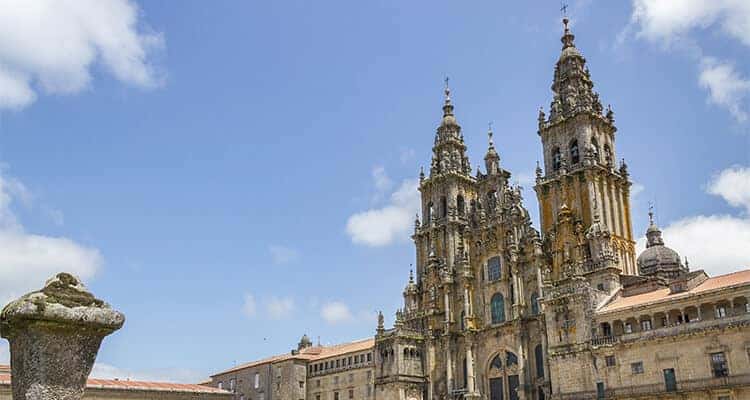
For centuries, the Cathedral of Santiago de Compostela has always been the philosopher’s stone for pilgrims on their journey along the Camino.
Obviously, this cathedral is the jewel in the crown not only because it is the end goal of the pilgrims, but for its history and architectural beauty.
How was the Santiago de Compostela cathedral built?
Some will say that this story is a myth or a legend. The most faithful will say that it is an example of Lord’s works. The truth is that the result of this story is a magnificent masterpiece: the cathedral of Santiago de Compostela.
The story tells that in 814 AD a shepherd named Pelayo witnessed strange lights in the sky. They led him to the tomb of St James. This witness was declared a miracle by Bishop Teodomiros of Iria and informed king Alfonso II “The Chaste” of Asturias and Galicia about it. King Alfonso then ordered a chapel to be built on the site. It is said that the king was the first pilgrim to this shrine.
Over the years the various kings wanted to leave their mark.
King Alfonso III in 829 ordered to transform into a church the modest chapel ordered by Alfonso II, and later into a pre-Romanesque church in 899.
In 997 this primitive church was reduced to ashes by Almanzor, commander of the army of the caliph of Cordoba. But still more interesting is to know that the doors and bells of this church were transported on the shoulders of Christian prisoners up to the Aljama mosque in Cordoba. This same action was repeated in 1236 but from a different angle. When Cordoba was taken by King Fernando III of Castile he ordered that these same doors and bells be transported by Muslim prisoners to Toledo. The bells and doors were included in the cathedral of Santa Maria in Toledo.
The construction of the current cathedral started in 1075 under the reign of Alfonso VI and the patronage of Bishop Diego Pelaez.
The construction of the cathedral was interrupted on different occasions and it wasn’t until 1122 that the last stone was laid, according to Liber Sancti Iacobi, In 1128 the cathedral was consecrated in the presence of Alfonso IX.
So if you wonder how old the Cathedral of Santiago de Compostela is, it is 809 years old now!
Who built the cathedral of Santiago de Compostela?
The cathedral of Santiago de Compostela was built mainly in granite and following the same plan as the monastic brick church of San Sernin of Toulouse, one of the largest Romanesque buildings in France.
Bernardo el Viejo, Maestro Admirable, and Roberto were in charge of the construction of the Romanesque Cathedral in the year 1075. Then, in 1100 the Master of Platerias continued the work. Finally, in 1168, Master Mateo overtook the task of finishing the cathedral, including the western closure and the construction of the Choir in the main nave.
Who is buried in Santiago de Compostela Cathedral?
The cathedral of Santiago is the alleged site where the ashes of the apostle St. James remain. Which makes the cathedral one of the three churches known in the world constructed over the tomb of an apostle of Jesus.
Many interesting things and stories have happened in Santiago de Compostela Cathedral. All of them were hidden in the walls of the cathedral but thanks to the amazing work of dedicated historians and scholars, the walls of Santiago’s impressive cathedral are starting to share their story. One of them is Dr Jenny Alexander from the University of Warwick who we interviewed about her work uncovering the secrets of the cathedral walls.
Cathedral Restoration
The restoration works of the Cathedral of Santiago de Compostela are expected to be completed at the beginning of the Holy Year 2021.
As a result of COVID-19, the work was stopped for a few months. However, now they are progressing at a positive pace with some limitations linked to supplies and social distancing. At this stage, there are some works to be completed on the main nave and the cloister, on the Quintana facade including the Holy Door, and the Torre da Vela, as informed the Galician Minister of Culture and Tourism, Roman Rodrigues.
Santiago Cathedral – Opening Hours
- Open every day, from 9 am to 6:45 pm.
Museum:
- Tuesday to Sunday, from 10:30 am to 2:30 pm.
Portico of Glory and Torre of the Carraca:
- Tuesday and Wednesday, from 9:30 am to 2:30 pm
- Thursday to Sunday, from 9 am to 2:30 pm.
Archive – Library
- Monday to Friday, from 9:00 am to 1:30 pm.
- Closed in August and bank holidays.
The Cathedral of Santiago de Compostela hides a lot of secrets and mysteries. One of them is a Holy door that grants those who pass through it a plenary indulgence.
Back to top page ^



 Flexible itineraries
Flexible itineraries  Luggage transfers
Luggage transfers  Private rooms & bathrooms
Private rooms & bathrooms
-260x260.png)
